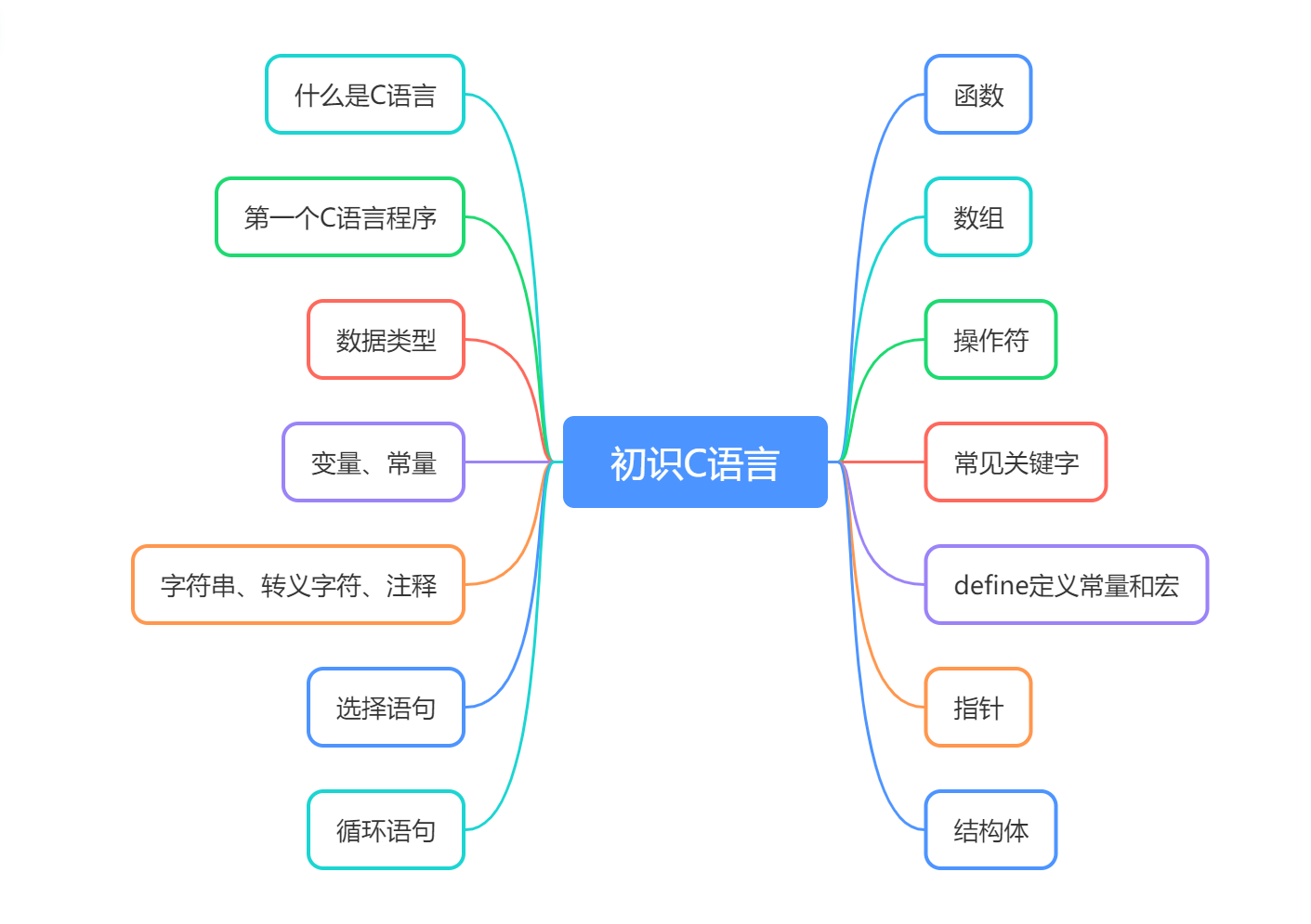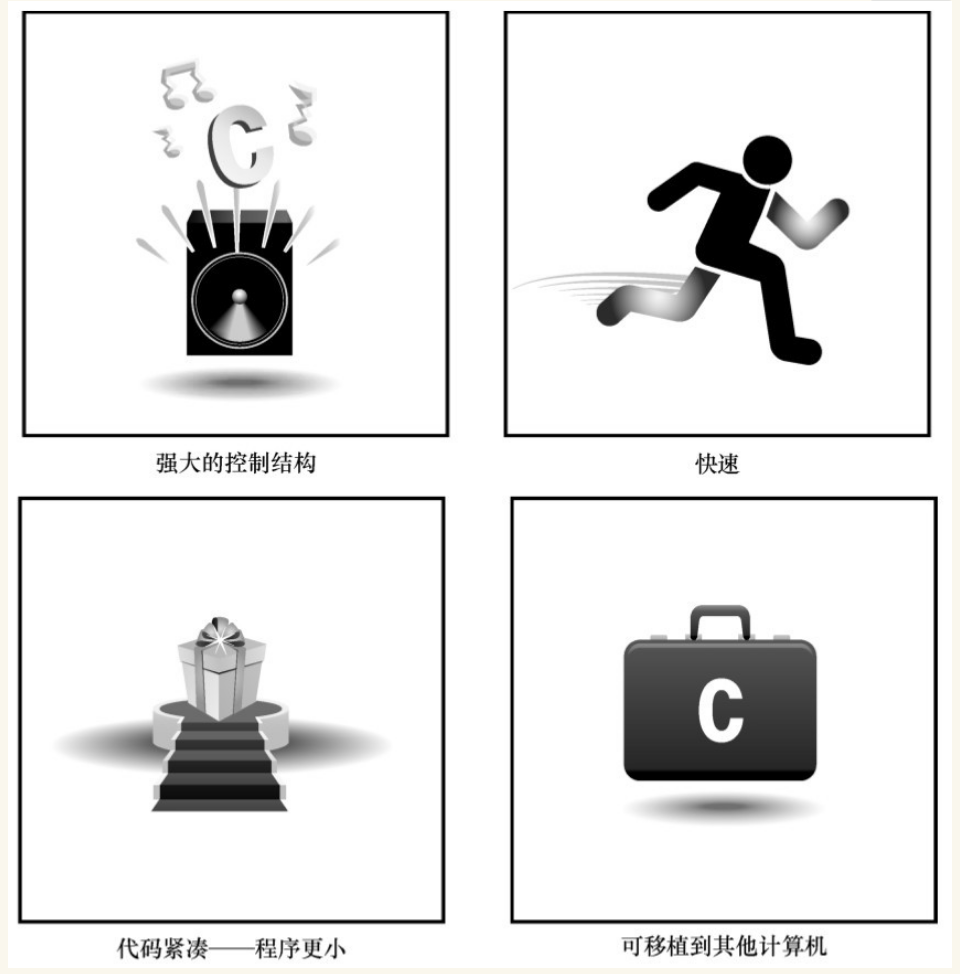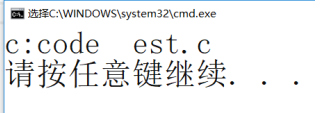To learn a language, you must be broad before you are proficient.
Here, I will sort out the knowledge points of C language, which can be divided into the following 14 categories.
catalogue
2. The first C language program
5. String, escape character, comment
12. define constants and macros
Made a guide map and be clear

1. What is C language?
C language was born in Bell Labs in 1972. It is portable and powerful.
C language is a high-level programming language, process oriented.
C language has its own rules. At present, there are two general standards C99 and C11.
The following are the advantages of C language: (see C Primer Plus for details)

2. The first C language program
#include <stdio.h>
int main()
{
printf("hello world");
return 0;
}#include <stdio. h> Refers to the calling header file
stdio is standard input output. When printf() and scanf() functions are used, they need to be called.
int stands for integer type
main() is a function, which is the entry of a program. There is only one function in a project.
return 0; Indicates the end of the program.
3. Data type
Three types: character type, integer type and floating point type
The unit is byte (1 byte = 8 bit), and the rest are 1024 times
| data type | name | Byte size | Formatter |
| char | character | 1 | %c |
| short | Short | 2 | %d |
| int | integer | 4 | %d |
| long | Long integer | 4 | %d |
| long long | Longer integer | 8 | %d |
| short | Single-precision floating-point | 4 | %f |
| double | Double precision floating point number | 8 | %lf |
4. Variables and constants
As the name suggests, a constant is a constant quantity, and a variable is a variable quantity
Variable:
Variables can be divided into local variables and global variables
Here is a distinction between scope and lifecycle.
Scope:
Local variable scope refers to the local scope of the variable.
The scope of the global variable is the whole project.
Life cycle:
The life cycle of a local variable starts at the scope and ends at the scope.
The life cycle of global variables is the life cycle of the whole program.
#include <stdio.h>
int a = 10; //This is a global variable
int main()
{
int a = 9; //This is a local variable
printf("%d", a);
return 0;
}
As shown in the code, when a local variable conflicts with a global variable, the local variable takes precedence
constant
Constants can be divided into three types: const modification, #define defined identifier constants and enumeration constants.
#include <stdio.h>
enum Sex
{
MALE,
FEMALE,
SECRET
};
//Mal, female and secret in parentheses are enumeration constants
int main()
{
3.14;//Literal constant
1000;//Literal constant
const float pai = 3.14f; //const modified constant
pai = 5.14; //Constants cannot be modified
#define MAX 100 //#Identifier constant for define
return 0;
}
5. String, escape character, comment
character string
String, that is, multiple characters.
There is no corresponding keyword in C language, but it can be run with character array.
#include <stdio.h>
int main()
{
char arr1[] = "hello";
char arr2[] = {'h', 'e', 'l', 'l', 'o'};
char arr3[] = {'h', 'e', 'l', 'l', 'o', '\0'}};
return 0;
}
arr1 is a standard string notation.
Note the comparison between arr2 and arr3,
There is an extra '\ 0' in arr3, which is the end statement of the string. When the string is written in double quotation marks, it is added by default (that is, '\ 0' in arr1 by default)
Since there is no end flag for arr2, arr2 is output at this time

There was perfect garbled code.
arr3 is the corresponding solution, which shows the importance of '\ 0'.
Note: '\ 0' occupies one byte of memory space, but it itself is not counted as string content.
Escape character
| Escape character | interpretation |
| \' | Used to represent character constants' |
| \" | Double quotation marks used to represent the inside of a string |
| \\ | Used to represent a backslash to prevent it from being interpreted as an escape sequence character. |
| \a | Warning character, beep |
| \b | Backspace character |
| \f | Feed character |
| \n | Line feed |
| \r | enter |
| \t | Horizontal tab |
| \v | vertical tab |
| \? | Used when writing consecutive question marks to prevent them from being parsed into three letter words |
| \ddd | ddd represents 1 ~ 3 octal digits. For example: \ 130 X |
| \xdd | dd represents 2 hexadecimal digits. For example: \ x30 |
These escape characters do not need to be memorized specially. They are familiar with them when they are often used.
#include <stdio.h>
int main()
{
printf("c:\code\test.c\n");
return 0;
}So what does this line of code output?
Note that the escape characters' \ c ',' \ t 'and' \ n 'are escape characters, and' \ c 'has no corresponding meaning. Only' c 'is printed

notes
Comments are used to supplement the code, and some unnecessary code can also be removed
Always write notes!
Always write notes!
Always write notes!
There are two styles of annotation.
1)/* xxxxxxxx */
2) / / xxxxxxxxxxxx (recommended)
Add the shortcut key of vs: ctrl + k, and then press ctrl + c
6. Select a statement
There are two kinds of selection statements: switch and if statements
I won't go into detail here. I'll talk about it in depth after learning. I'll directly demonstrate the usage of the code
#include <stdio.h>
int main()
{
int coding = 0;
printf("Will you type the code? (option 1) or 0):>");
scanf("%d", &coding);
if(coding == 1)
{
printf("Hold on, you'll have a good time offer\n");
}
else
{
printf("Give up and go home to sell sweet potatoes\n");
}
return 0;
}Then write the same with switch:
#include <stdio.h>
int main()
{
int coding = 0;
printf("Will you type the code? (option 1) or 0):>");
scanf("%d", &coding);
switch(coding)
{
case 1:
printf("Hold on, you'll have a good time offer\n");
break;
case 2:
printf("Give up and go home to sell sweet potatoes\n");
break;
}
return 0;
}
7. Circular statement
There are three types of circular statements: while, for, and do while
Here is a brief demonstration of the use of while, which will be discussed later.
//An instance of a while loop
#include <stdio.h>
int main()
{
int line = 0;
while(line<=100000)
{
line++;
printf("I'll keep trying to type the code\n");
}
if(line>100000)
printf("Win baifumei\n");
return 0;
}8. Function
Function is to simplify the code and facilitate repeated use. Directly on the instance.
#include <stdio.h>
//Implement an addition function
int Add(int x, int y)
{
int z = x+y;
return z;
}
int main()
{
int num1 = 0;
int num2 = 0;
int sum = 0;
printf("Enter two operands:>");
scanf("%d %d", &num1, &num2);
sum = Add(num1, num2);
printf("sum = %d\n", sum);
return 0;
}9. Array
An array is a collection of elements of the same type.
Here are some precautions:
1) The byte size of the array follows the capacity of the array.

The result of this figure is 4

The result of this figure is 6
2) The size of the array must be constant.
const int num = 10;
Where num is a constant variable,
That is, num itself is a variable, but after const modification, it becomes a constant from the syntax level and is still a variable in essence.
int arr[num] = {0};
So this way of writing is wrong.
10. Operator
Here is a brief list, which will be sorted out later:
1.Arithmetic operator Used for various numerical operations. Including plus(+),reduce(-),ride(*),except(/),Seeking remainder(Or modular operation,%),Self increasing(++),Self subtraction(--)There are seven kinds. 2.Relational operator Used for comparison operations. Including greater than(>),less than(<),be equal to(==), Greater than or equal to(>=),Less than or equal to(<=)Sum is not equal to(!=)Six. 3.Logical operator Used for logical operations. Including and(&&),or(||),wrong(!)Three. 4.Bitwise operator The quantity involved in the operation is calculated according to binary bits. Including bit and(&),Bit or(|),Bit non(~),Bit exclusive or(^),Shift left(<<),Shift right(>>)Six. 5.Assignment Operators It is used for assignment operation and is divided into simple assignment(=),Compound arithmetic assignment(+=,-=,*=,/=,%=)And compound bit operation assignment(&=,|=,^=,>>=,<<=)There are 11 species in total. 6.Conditional operator This is a ternary operator for conditional evaluation(a ? b : c). 7.Comma Operator Used to combine several expressions into one expression(a,b, c). 8.Pointer operators Used to fetch content(*)And fetch address(&)Two operations. 9.Byte count operator Used to calculate the number of bytes occupied by the data type(sizeof). 10.Special operator Bracketed(),subscript[],member(→,.)And so on.
11. Common keywords
auto break case char const continue default do double else enum extern float for goto if int long register return short signed sizeof static struct switch typedef union unsigned void volatile while
You don't have to memorize it. You can remember it when you use it more. I'll talk about it later.
12. define constants and macros
Macros are similar to functions. See the code for specific usage
//define defines an identifier constant
#define MAX 1000
//define macro
#define ADD(x, y) ((x)+(y))
#include <stdio.h>
int main()
{
int sum = ADD(2, 3);
printf("sum = %d\n", sum);
sum = 10*ADD(2, 3);
printf("sum = %d\n", sum);
return 0;
}13. Pointer
To understand pointers, you need to understand memory.
Memory is a particularly important memory on the computer. The operation of programs in the computer is carried out in memory.
Therefore, in order to use memory effectively, the memory is divided into small memory units, and the size of each memory unit is 1 byte.
In order to effectively access each unit of memory, the memory unit is numbered. These numbers are called the address of the memory unit.
#include <stdio.h>
int main()
{
int num = 10;
# //Fetch the address of num
//Note: there are 4 bytes of num, each byte has an address, and the address of the first byte (smaller address) is taken out
printf("%p\n", &num); //Print address,% p is printed as an address
return 0;
}
How to store the address needs to define the pointer variable.
#include <stdio.h>
int main()
{
int num = 10;
int *p = # //Take the address of num and store it in p, which is the pointer variable
*p = 20; //'*' here is the dereference character, that is, parse p, and then store 20 in the parsed address
return 0;
}
Of course, a pointer variable is essentially a variable and has a size.
#include <stdio.h>
int main()
{
printf("%d\n", sizeof(char *));
printf("%d\n", sizeof(short *));
printf("%d\n", sizeof(int *));
printf("%d\n", sizeof(double *));
return 0;
}
Conclusion: the pointer size is 4 bytes on 32-bit platform and 8 bytes on 64 bit platform.
14. Structure
Describe a student. The student includes: Name + age + gender + student number.
Generally, if a data type cannot be stored, the structure is used to represent this kind of data.
Because structures enable C language to describe complex types.
For example:
struct Stu
{
char name[20];//name
int age; //Age
char sex[5]; //Gender
char id[15]; //Student number
};//Here ';' Not less
//Initialize structure information
struct Stu s = {"Zhang San", 20, "male", "20180101"};
//. access operators for structure members
printf("name = %s age = %d sex = %s id = %s\n", s.name, s.age, s.sex, s.id);
//->Operator
struct Stu *ps = &s;
printf("name = %s age = %d sex = %s id = %s\n", ps->name, ps->age, ps->sex, ps-
>id);I have sorted out the C language knowledge points here, and I will continue to update them in the later learning,
Welcome to make corrections. I think it's good. You can point a praise.